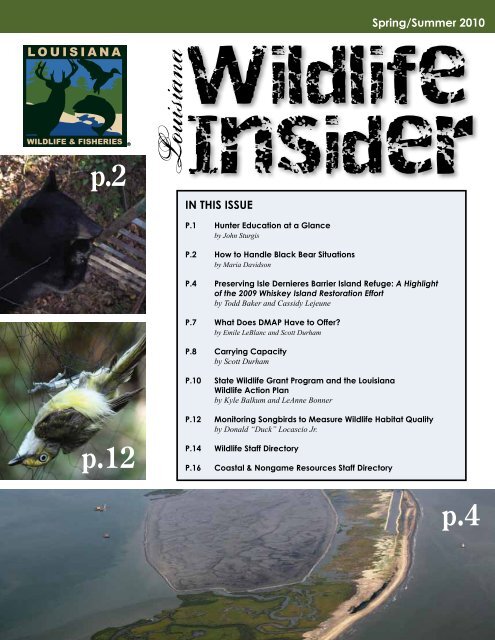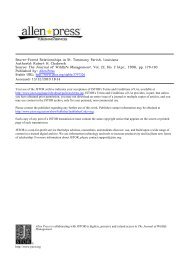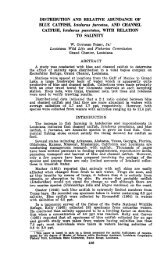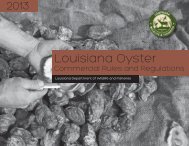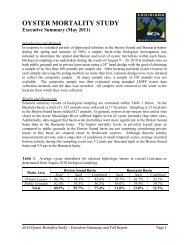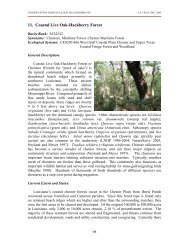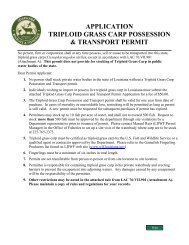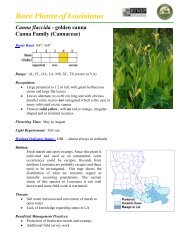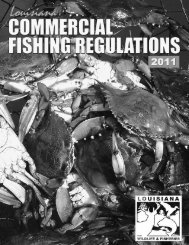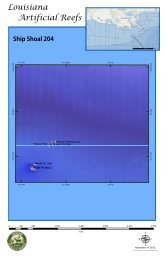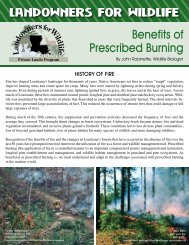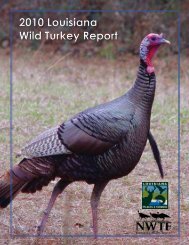Wildlife Insider Spring Summer 2010 - Louisiana Department of ...
Wildlife Insider Spring Summer 2010 - Louisiana Department of ...
Wildlife Insider Spring Summer 2010 - Louisiana Department of ...
Create successful ePaper yourself
Turn your PDF publications into a flip-book with our unique Google optimized e-Paper software.
Rememberto tag yourdeer this seasonHunters must validate deer within 72 hours bycalling the validation toll free number or byusing the validation web site:866-484-4805https://www1.la.wildlifelicense.com/start.phpImportant: Do not remove the tags from the DeerHarvest Report Card until you have killed a deer; at thatpoint the tag is removed from the Deer Harvest ReportCard and attached to the animal. Tags removed from theDeer Harvest Report Card prior to killing a deer are nolonger valid and if lost by the hunter will not be replaced.(Duplicate tags will be available to replace lost tags at acharge to the hunter.)
HunterEducationat aGlanceBy John Sturgis,LDWF EducationProgram ManagerLDWF file photoNote small size <strong>of</strong> the electric clay target thrower usedduring hunter education instruction.<strong>Spring</strong>/<strong>Summer</strong> <strong>2010</strong>The <strong>Louisiana</strong> Hunter Education Programhas a 35-year history <strong>of</strong> makinghunting a safer sport in <strong>Louisiana</strong>. Begunin 1974, it has come a long way andhas gone through a number <strong>of</strong> changes tohave evolved into its present form. Theprogram was started by a handful <strong>of</strong> newlyhired staff who embarked on a mission <strong>of</strong>developing a structured hunter educationcourse, as well as recruiting and training avolunteer instructor force that now stands at1,700 strong.Methods <strong>of</strong> course delivery have progressedthrough the years. Old 16mm filmprojectors and flip charts have given wayto computerized technology. PowerPointpresentations and interactive computer programsare now the norm. Clay target throwersused for live fire instructions were solarge and heavy, they had to be towed ona utility trailer, but are now small enoughto be loaded into the back <strong>of</strong> a pickup truckby one person (pictured above). Student recordsthat were once entered into databasesby hand can now be scanned and electronicallysubmitted for storage. Students, whoonce had to contact a person by phone toregister for a hunter education course, cannow register completely on-line withouthaving to speak to a person. The internethas provided a great opportunity for advancementin hunter education. People cannow take a hunter education course on-linein the convenience <strong>of</strong> their own home, aswell as access a number <strong>of</strong> other useful resources.Knowledge <strong>of</strong> hunting incidentsthat went unconfirmed are now investigatedby trained personnel, and results are enteredinto a national database that is analyzed andused in the prevention <strong>of</strong> future hunter incidents.The <strong>Louisiana</strong> Hunter EducationProgram has expanded through the yearsin its efforts to provide advanced trainingin weapons other than shotguns and rifles.Bow and muzzleloader hunter educationcourses are <strong>of</strong>fered for those who enjoythe challenge <strong>of</strong> pursuing game with moreprimitive hunting equipment.While new technology has allowed advancementsin course delivery, some thingsdo not change. One being the crucial rolethat volunteer hunter education instructorsplay in this important program. Thebackbone <strong>of</strong> the <strong>Louisiana</strong> Hunter EducationProgram has always been its volunteerswho unselfishly dedicate countless hours <strong>of</strong>their personal time to give back to the sport<strong>of</strong> hunting. Without their service it wouldbe a futile effort, and they are to be salutedfor their accomplishments.Similarly, while we utilize new technologyand approaches to deliver our messageto meet the cultural needs <strong>of</strong> each new generation,the message is always the same becausethe basic principles <strong>of</strong> safe firearmshandling remains unchanged. No matterhow many different ways we find to teach aperson to handle a firearm safely, we strivefor the same desired results - a person whois a responsible, knowledgeable and safehunter. In hunter education, we teach whatis called the 10 commandments <strong>of</strong> firearmssafety. These 10 commandments areintended to serve as guidelines for huntersto follow to prevent a hunting incident. Ifhunters would only observe the first fourvirtually every hunting incident could beprevented. They are:1. Always point your firearms muzzle in asafe direction.2. Keep your finger <strong>of</strong>f <strong>of</strong> the trigger untilready to fire.3. Be sure <strong>of</strong> your target, what is in frontand beyond it.4. Treat all firearms as if they are loadedat all times.Remember these rules <strong>of</strong> safe firearms handling.Burn them to your memory and thinkabout every move you make with a firearmwhen it is in your hands. Have a safe andsuccessful hunting season.For More InformationSpecific information on huntereducation classes can be foundon the <strong>Louisiana</strong> <strong>Department</strong> <strong>of</strong><strong>Wildlife</strong> and Fisheries website:http://www.wlf.louisiana.gov/education/huntereducation/1
Photo courtesy <strong>of</strong> Walt Cottontree or pole. Bears also are less likely to forage for grain on the ground dispensedfrom a timed feeder. They prefer to belly up to the bar at a trough or overturnedfeeder.Bears are extremely inquisitive and will sometimes follow a hunter’s trail tothe stand. It is not uncommon for a bear to place his front feet on the ladder andpeer up into the stand in an attempt to discover what is up there. This situation canusually be resolved by standing and moving about on the stand and speaking to thebear to allow him to see and hear you. Once their curiosity is satisfied, they usuallygo on their way.Another encounter that sometimes occurs is a hunter moving through thickbrush and running across a bear nest. Females readily nest on the ground to producecubs. This occurs during the den season (late December through April).Ground nests are most <strong>of</strong>ten located in slash piles, felled tree tops, blackberrythickets and thick palmetto. This type <strong>of</strong> encounter is likely to cause the female torun away from her nest. The cubs will bawl loudly in protest at being abandoned.This vocalization will bring the female back quickly as soon as you leave the area.Even hunters following all <strong>of</strong> the proper precautions can occasionally encountera bear while hunting. Although bears are generally shy and for the most parttry to avoid humans, hunting, by its nature, places humans in close proximity tobears. When a surprise encounter occurs, the best course <strong>of</strong> action is to detouraround where the bear is feeding or resting. Go back the way you came and accessyour intended destination from another direction. If you unintentionally encountera bear at close range; raise your hands above your head to appear larger than youare. Speak in a normal voice to allow the bear to identify you as human. Back awayuntil it is safe to turn and WALK (DO NOT RUN) away. Bears have poor vision,but have a keen sense <strong>of</strong> smell. They will sometimes stand on their hind legs whenfaced with something they can’t identify. They are trying to catch your scent to determinewhat they are encountering. In the unlikely event that a bear attack occurs,DO NOT PLAY DEAD. That is a technique used for grizzly bears. Fight back withanything available. Many times black bear attacks were stopped when the personfought back violently.The best tip for insuring hunter safety and peace <strong>of</strong> mind is to carry bear spray.It is readily available on the web, affordable, easy to use and will send the mostcurious <strong>of</strong> bears running. There are several brands available, just be sure to buy aproduct labeled “bear spray.” Most come with a convenient belt holster.The majority <strong>of</strong> questions hunters have concerns their safety around bears. It isimportant for hunters to educate themselves about bears and bear behavior. Theyshould take the proper precautions and remain aware while in the woods. Youngerhunters should be coached on how to respond to bear presence, and be providedwith bear spray and taught how to use it.The goal <strong>of</strong> the <strong>Louisiana</strong> <strong>Department</strong> <strong>of</strong> <strong>Wildlife</strong> and Fisheries bear programis to restore bear numbers to a sustainable level that will allow for a bear season inthe future.Figure 4. Deer feeder located within a winterplot and protected by electric fencing.<strong>Spring</strong>/<strong>Summer</strong> <strong>2010</strong>Figure 2. (above) Deer and bear captured with trail cam.Figure 3. (below) Raised deer feeders will limit damageby bears.3Photo courtesy <strong>of</strong> Sweeny Enterprises LDWF file photo
Figure 2. Land change 1887 vs. 1996 (Penland et. al. 2003)as protection for coastal communities by reducingstorm surge associated with tropicalstorms and hurricanes.According to the National WetlandsCenter, the Terrebonne Basin, which includesIDBIR, has the second highest erosionrate in <strong>Louisiana</strong> (Barras et al. 1994)(Figure 2.). It has experienced as much as10.2 square miles <strong>of</strong> loss per year over thelast few decades. Barrier islands are part <strong>of</strong>the final stages <strong>of</strong> delta degradation and arequite vulnerable to erosion. According toMcBride et al. 1989, the Isle Dernieres barrierisland chain is the most rapidly erodingcoastline in the United States. A study byPenland et al. 2003 indicated that IDBIR isexperiencing an average shoreline erosionrate <strong>of</strong> 38.7 feet per year on the gulf sideand 8.2 feet per year on the bay side <strong>of</strong> theislands. Due to the extensive wetland loss atand in the vicinity <strong>of</strong> IDBIR, over 85 milliondollars have been spent or allocated tokeeping IDBIR from becoming a subaqueousshoal.Coastal restoration at IDBIR began in1991 when Wine Island was recreated bypumping dredge material from the HoumaNavigation Canal onto the remnants <strong>of</strong> theisland which had eroded to a shallow shoal.The project was funded via the Water ResourcesDevelopment Act <strong>of</strong> 1986. The areawas wrapped with a rock dike and materialwas pumped to a +4 feet to +7 feet elevation.Also in the early 1990s, the development<strong>of</strong> large scale beach/marsh restorationprojects were initiated via the Coastal WetlandsPlanning Protection and RestorationAct (CWPPRA). In 1999, the Isle DernieresRestoration East and Trinity IslandsProjects (TE-20 and TE-24) were created.These projects were designed to rebuildportions <strong>of</strong> these islands using a hydraulicdredge. The projects included marsh creation,dune creation, sand fences to trapwind blown sand and vegetation plantings.Subsequently, the Whiskey Island RestorationProject (TE-27) was constructedbetween 1998 and 2000. This project alsoutilized a hydraulic dredge to create a dune/marsh platform and fill in a breach <strong>of</strong> theisland (approx. 657 acres). The project alsoincluded installation <strong>of</strong> sand fences andvegetation plantings. In 2007, a secondhydraulic dredge project was implementedat Trinity and East Islands (New Cut Duneand Marsh Restoration Project, TE-37).This project included marsh and dune creation,beach nourishment, installation <strong>of</strong>sand fences and planting <strong>of</strong> native vegetation.The primary objective <strong>of</strong> this projectwas to solidify a breach between the twoislands by widening the island in an areaknow as “New Cut.” Also in 2007, materialwas pumped from the Houma NavigationCanal to Wine Island in an effort to beneficiallyuse dredge material to widen theisland. Unfortunately, this project had minimalbenefits due to the low quality <strong>of</strong> materialpumped from the navigation channeland impacts from hurricanes Gustav andIke. Overall, these projects were critical forthe longevity <strong>of</strong> the islands. Without restoration,the islands were expected to disappearby 2004 (McBride et al. 1989).A majority <strong>of</strong> restoration at IDBIR utilizeda hydraulic dredge to borrow sedimentfrom water bottoms to nourish thebeach and bayside marshes <strong>of</strong> the islands.However, a different technique was utilizedfor Raccoon Island. In 1997, eight segmentedbreakwaters were constructed usinglarge boulders along the gulfside <strong>of</strong> theisland to reduce erosion (Raccoon IslandBreakwaters Demonstration Project, TE-29) (Figure 3). This technique proved tobe a successful way <strong>of</strong> decreasing erosionrates and, as a secondary/unanticipated effect,resulted in the trapping <strong>of</strong> sand depositswhich increased the width <strong>of</strong> the island.Subsequently, eight additional breakwatersand a rock groin were added in 2007 toprovide additional shoreline protection andtrap sediment (Raccoon Island ShorelineProtection/Marsh Creation Project, TE-48).This project also includes a second phasethat includes a marsh creation component(60 acres) and vegetation plantings. Thisphase <strong>of</strong> the project was expected to be initiatedin late 2009 or early <strong>2010</strong>.In 2009, the preservation <strong>of</strong> IDBIR continuedwhen a second restoration project atWhiskey Island was initiated. On February11, the <strong>Louisiana</strong> Office <strong>of</strong> Coastal Restora-Photo courtesy <strong>of</strong> Weeks MarineDredge and material pumped into dune creation site.Winter <strong>2010</strong>LDWF file photo5
Photos courtesy <strong>of</strong> Weeks MarineFigure 4. Aerial photo during dike construction <strong>of</strong> the Whiskey Islandmarsh creation site.Figure 6. September 2009 aerial photo <strong>of</strong> material pumped into marsh anddune creation sites.tion and Protection (OCPR) and the EnvironmentalProtection Agency (EPA) issueda notice to proceed to Weeks Marine, Inc. toinitiate the construction <strong>of</strong> a $23.1 millionrestoration project designed to impede theerosion <strong>of</strong> Whiskey Island. LDWF Coastaland Nongame Resources Division biologicalstaff coordinated with OCPR, EPA andWeeks Marine personnel on a routine basisto ensure LDWF management objectiveswere met.In March 2009, Weeks Marine mobilizedequipment (dragline, excavators,boats, barges, dredge pipe, etc.) and initiatedthe construction <strong>of</strong> a containment dikefor the 316-acre marsh creation component<strong>of</strong> the project (Figure 4). During the dikeconstruction process, Weeks also dredgedexperimental tidal creeks within the marshcreation site. These creeks were dredgedto -6’ NAVD 88 and were designed withthe idea that differential settlement wouldcause the creeks to appear after the completion<strong>of</strong> the project. Spill boxes were also installedin the containment dike to allow forde-watering <strong>of</strong> the dredge material.During the construction <strong>of</strong> the dikes, sixAtlantic bottlenose dolphins were accidentlytrapped in the marsh creation site. To rectifythe situation, Weeks Marine (via inputgovernmental agencies and the NOAA MarineMammal Stranding Program) dredgeda 100-foot breach in the levee to allow thedolphins to swim out <strong>of</strong> the area. Subsequently,a 30-inch hydraulic cutter headdredge called the “E.W. Ellefsen” was usedto fill the marsh creation portion <strong>of</strong> the project.When pumping was initiated, the dolphinsleft the marsh creation area. Thus, nocapture and release efforts were required.Approximately 2.4 million cubic yards<strong>of</strong> dredge material from the Gulf <strong>of</strong> Mexicowere pumped into the marsh creation areato an elevation <strong>of</strong> +2.5’ NAVD 88 (Figure5). While building marsh, dike constructionwas initiated for the dune creation segment<strong>of</strong> the project. The dikes were created (in apreviously designed alignment) to containmaterial for the 12,770 linear feet <strong>of</strong> dunethat paralleled the Gulf shoreline for theentire length <strong>of</strong> the island. The cutter headdredge was used to fill the dune after themarsh creation component was completed.Approximately 242,000 cubic yards <strong>of</strong> materialwere pumped into the dune site to anelevation <strong>of</strong> +6’ NAVD 88. In September2009, Weeks Marine completed the hydraulicdredge work and initiated the final stages<strong>of</strong> the project which included grading/shaping<strong>of</strong> the dune, final elevation surveys, anddemobilization (Figure 6).Other activities that remain to be completedare the construction <strong>of</strong> 13,000 feet <strong>of</strong>sand fences, degrading <strong>of</strong> the containmentdikes to +2.5’NAVD 88 on the east andwest sides <strong>of</strong> the marsh creation site, backfilling<strong>of</strong> the access channel to the island,creating 70-foot gaps in the northern containmentdike to allow for tidal exchangein creeks, dispersing bermuda and gulf ryegrass, and possibly degrading the northerndikes on the bayshore <strong>of</strong> the island. In addition,OCPR has issued a contract to plantnative marsh vegetation such as bitter panicum(Panicum amarum), sea oats (Uniolapaniculata), wire grass (Spartina patens),black mangroves (Avicennia germinans),smooth cordgrass (Spartina alterniflora),seacoast bluestem (Schizachyrium scoparium)and seashore dropseed (Sporobolus virginicus).The vegetation was to be plantedin the spring <strong>of</strong> <strong>2010</strong>.Thanks to federal and state governmentcoordination, a significant amount <strong>of</strong> timeand money have been expended to preserveIDBIR over the past 18 years. Restorationsuch as the projects highlighted in this articlehas extended the lifespan <strong>of</strong> these fragileislands and provided goods and services tothe general public. Outlook for future restorationfunding is promising, and IDBIR is<strong>of</strong>ten considered when planning new projectsdue to its fragile condition. Frequentand repetitive restoration is needed at ID-BIR to preserve <strong>Louisiana</strong>’s coastal barrierisland resources because natural causes andman’s activities have changed the normalaccretion process along our coasts.Literature citedBarras, J.A., P.E. Bourgeois, and L.R.Handley. 1994. Land loss in coastal <strong>Louisiana</strong>1956-90. National Biological Survey,National Wetlands Research Center OpenFile Report 94-01. 4 pp. 10 color plates.McBride, R.A., K. Westphal, S. Penland, B.Jaffe, and S.J. Williams. 1989. Erosion anddeterioration <strong>of</strong> Isle Dernieres Barrier IslandArc, <strong>Louisiana</strong>: 1842-1988. AAPGBulletin 73: 1182-1188.Penland, S., C. Zganjar, K.A. Westphal, P.Connor, A. Beall, J.H. List, and S.J. Williams.2003. Shoreline change posters <strong>of</strong>the <strong>Louisiana</strong> Barrier Islands, 1885-1996:U.S. Geological Survey Open-File Report03-398, CD-ROM.For More InformationFor additional information aboutIDBIR, please call Todd Bakeror Cassidy Lejeune at 337-373-0032.6 <strong>Louisiana</strong> <strong>Wildlife</strong> <strong>Insider</strong>
What DoesDMAPHave toOffer?By Emile P. Leblanc, DMAP Coordinator,and Scott Durham, Deer Program LeaderLDWF biologist conducting deer browse survey.The Deer Management Assistance Program(DMAP) was initiated in the 1980sto allow additional antlerless deer harvestopportunity where the season limit was notadequate to reach management objectives.Additionally, there was an emphasis on reducingthe harvest <strong>of</strong> 1.5-year-old buckswhen hunters expressed the desire to shootbetter quality bucks. Promoting deer densitiesthat are in balance with the habitat andherds with more even sex ratios and betterage structures are fundamental principalsthat more recently have become known asquality deer management (QDM).DMAP has been a very important andsuccessful program, allowing <strong>Louisiana</strong><strong>Department</strong> <strong>of</strong> <strong>Wildlife</strong> and Fisheries(LDWF) field biologists an excellent way tointeract with the public and educate huntersabout good wildlife conservation methodsand principals. The Landowner AntlerlessDeer Tag Program (LADT) followed andwas created for smaller landowners withless management capability, but the sameneed for additional antlerless deer harvest.LADT also addresses growing nuisancedeer issues in less rural habitats, therebygiving increased opportunities to reducedeer numbers in suburban areas. DMAPenrollment started to experience a declinewhen the LADT rules were changed to allowlarger acreages to participate.With the recent implementation <strong>of</strong> statewidedeer tagging, both programs have seenadditional drops in participation. However,the need for ecologically and scientificallysound management <strong>of</strong> private lands hasnever been greater. Adequate deer harvestis a fundamental component <strong>of</strong> good landstewardship, and harvests should be basedon habitat parameters, deer population andunique environmental variables.The goal <strong>of</strong> DMAP continues to be to<strong>Spring</strong>/<strong>Summer</strong> <strong>2010</strong><strong>of</strong>fer interested hunters, landowners andmanagers in-depth, pr<strong>of</strong>essional technicalassistance in managing deer populationsand their habitats. Secondarily, the programseeks to educate participants on sound deermanagement and wildlife habitat principalsacross the state. LADT provides basic informationand continues to <strong>of</strong>fer increasedharvest opportunity on smaller acreages andwhere nuisance deer issues exist.Besides assisting landowners and huntingclubs with technical assistance in managingand conserving local wildlife populations,the deer program gains detailedstatewide harvest information that is used tomake inferences to the deer population statusand make management decisions suchas season length and bag limits. Managingdeer populations are vital to maintainingnative plant diversity and viability, forestecosystem health, public safety and traditionalcultural richness.DMAP clubs have played a vital role inassisting LDWF track diseases. A recentexample was the blood collection effort toidentify the prevalence and range <strong>of</strong> thenew strain <strong>of</strong> bluetongue (BTV1) identifiedin south <strong>Louisiana</strong> in 2006. Statewide samplingefforts for chronic wasting diseasewould have consumed considerably moretime <strong>of</strong> staff biologists without willinghands from our DMAP cooperators. Likewise,the recently completed bottomlandhardwood deer movement and survival researchwould not have been possible withoutthe cooperation and support <strong>of</strong> severalmajor landowners enrolled in DMAP. Ourongoing parish breeding chronology researchwill continue to refine the differentbreeding periods across the state. Landownerrelationships and DMAP cooperatorshave been vital to the success <strong>of</strong> the deerprogram, and continue to be very importantLDWF file photoin attaining deer program objectives.The deer program, primarily throughDMAP, is committed to providing technicalassistance based on the most currentscientific principles and our personal fieldexperiences. Services <strong>of</strong>fered to participantsenrolled in DMAP include browseand habitat surveys every three years withaccompanying reports and recommendationsdesigned for the management objectivesthat cooperators choose. Included inthe reports are annual harvest reports andharvest and habitat recommendations. Presentationsat club meetings are provided asrequested. Herd health checks and breedingstudies are performed as needed. LDWFprivate land biologists can assist cooperatorswith habitat and forest management,camera surveys (to establish population indices)and mast surveys (to establish a mastspecies inventory). Stomach analyses canalso be performed to determine what plantsare being utilized during the winter months,which can provide insight into how huntersmight improve harvest strategies. In addition,pellet and track count cruises can beestablished to develop an additional populationindex to supplement other surveys. Thevarious surveys establish base-line data forthe property and, when collected over time,can document deer physical characteristicsand/or population trends. The observationlog was developed and distributed to cooperatorsas well as other interested personsto provide parish deer indices. Informationgathered from these logs can track differencesin population levels from differenthabitats and physiographic regions overtime. The cooperator also has a direct line <strong>of</strong>communication for any disease issues anddiagnosis that might arise on his property.The $25 enrollment and $0.05/acreDMAP fee has not increased since its beginning.New research in intensively managedbottomland hardwoods has revealed that itmay be possible to manage smaller propertiesfor quality deer. Management potentialincreases when working with neighboringlandowners or forming associations to increasethe size <strong>of</strong> the management unit.If you are interested in enrolling yourproperty in DMAP, additional informationcan be obtained from our web site (http://www.wlf.louisiana.gov/hunting/programs/animals/dmap.cfm) or one <strong>of</strong> our privatelands biologists located at our wildlife <strong>of</strong>ficesacross the state.For More InformationYou may also contact EmileLeBlanc, DMAP Coordinator, at225-765-2344 or by email ateleblanc@wlf.la.gov.7
CarryingCapacityBy Scott Durham,Deer Program LeaderThe term “carrying capacity” (CC) refersto the number <strong>of</strong> animals that a particularhabitat can support over time. It isnot constant or simple, but is an intricatemix <strong>of</strong> a number <strong>of</strong> factors that are changingall <strong>of</strong> the time. CC can change daily atfine levels or monthly with the changing <strong>of</strong>the seasons as environmental factors affecthabitat. On a longer term, landscape levelchanges such as human development, forestryand agricultural practices impact CC.Deer biologists spend a good deal <strong>of</strong> timetrying to determine the CC for individualtracts <strong>of</strong> lands within the different habitattypes across the state. From their assessments,they recommend harvest rates andthen compare them to historical data fora club or region. This process allows deerbiologists to make informed habitat managementand harvest recommendations tohunters, landowners and wildlife managers.There is no substitute for experience, includingworking knowledge <strong>of</strong> soils, plantsand forestry practices. There is usually notjust one way to accomplish your goals,truly illustrating why wildlife managementhas been coined as “an art and a science.”Determining CC is a perfect example <strong>of</strong>this adage.A very simple conceptual example <strong>of</strong>CC is to think <strong>of</strong> a pasture with cows. Thenumber <strong>of</strong> cows that pasture can supportdepends on the kind <strong>of</strong> grasses, rainfall, soiltype and condition, temperature and time<strong>of</strong> year, to name the basic variables. Eventhis simple example illustrates how CC isalways changing because the seasonal CCis less during a drought period than it wouldbe if rainfall was providing normal moisturelevels to the soil and grass. During thedormant season, the grass is not growing,but the cattle must be able to make it onwhatever food is still available. That is whycattle producers generally have a backupplan - hay, feed or a secondary place to takethose cattle if pasture conditions deterioratesufficiently to no longer support the herd.A mixed pine/hardwood forest is farmore diverse above the soil horizon thana simple pasture. Instead <strong>of</strong> only grass andcows, there are hundreds <strong>of</strong> herbaceousand woody plants, all competing for sunlightand nutrients. In addition to the plants,there are insects, amphibians, reptiles, birdsand mammals. Each group <strong>of</strong> plants and animalsis part <strong>of</strong> a complex web <strong>of</strong> life, andFigure 1. Young hardwood stand will produce hard mast in the future. Mast trees are especiallyimportant on poor soils or low productivity habitat. A period <strong>of</strong> lower browse availability must beendured in some portions <strong>of</strong> a tract to achieve the desired timber stand.Figure 2. Dense hardwood mid-stories must be inventoried. If undesirable regeneration is present,appropriate management action may need to be taken to promote more desirable species.each specimen in some way or another iscontributing or taking away something thatanother requires to survive in the long term.When things get too crowded in nature, thebackup plan initially is lower productivityor reproduction. Next may be dispersal oremigration and ultimately natural mortalitythrough increased predation, high parasitelevels and disease.The practical length <strong>of</strong> time to considerrelative to deer CC is probably at least ayear. Variations in terms <strong>of</strong> body characteristicssuch as antler development, weightsand lactation rates can easily be observedin the harvest data. Although it is extremelydifficult to quantify the impact <strong>of</strong> any one <strong>of</strong>these items individually, biologists considerannual fluctuations in precipitation, mastcrops, temperature, flooding, insect popula-tions, predator and competitor populations,and disease prevalence as factors affectingdeer production, abundance and, ultimately,harvest.Now we introduce another term, “lag,”which occurs when environmental andhabitat impacts are not fully expressed untilsome point in the future. For example,an extremely dry June could increase theincidence <strong>of</strong> hemorrhagic disease later thatsummer and fall, resulting in a 25 percentmortality event in an area. The deer populationis now lower there, possibly favoringthe deer that remain due to less competitionfor food sources.In another example, back to back hardspring freezes removes the white oak mastfor two years and the red oak mast for oneyear, reducing the average seasonal CC <strong>of</strong>LDWF file photos8 <strong>Louisiana</strong> <strong>Wildlife</strong> <strong>Insider</strong>
Figure 3. Mixed pine hardwood stands <strong>of</strong>ten <strong>of</strong>fer the most diverse array <strong>of</strong> deer browse species inthe understory.or even second, estrus cycle the next seasonif their body conditions do not improve.The resulting late born male fawns likelywill exhibit poorer antler development asyoung bucks due to the late and suppressedstart.To understand the long-term CC <strong>of</strong> atract <strong>of</strong> land or habitat type, an entire forestcycle must be considered. Even withinthe same soil region, a short-rotation pineplantation that is intensively managed forfast growing pulpwood or chip products,will have a different average annual deerCC than a more plant-diverse, long-rotationmixed pine/hardwood stand managedfor sawtimber. The forestry managementobjectives are different, and thus the forestmanagement regime is different.Recent research in pine plantations illustratesthe complexities <strong>of</strong> habitat quality.Mechanical, chemical and prescribed firetreatments and the timing <strong>of</strong> these managementtechniques have varying effects onplant composition and browse quantity andquality. Broadcast herbaceous weed controlreduces forage biomass significantly morethan banded herbaceous weed control (herbicidesapplied on a narrow strip along theplanted trees) (Jones et al. 2009). When anexotic woody plant, such as Chinese tallow(Triadica sebifera) or even a native likesweetgum (Liquidambar styraciflua), becomedominant in the under or mid-story,management action may be necessary toimprove wildlife habitat and forest regeneration.Selective herbicide and prescribedfire application can be used to increaseimportant deer forages in these situations(Mixon et al. 2009).The accompanying photos from thesame tract <strong>of</strong> land illustrate a variety <strong>of</strong> habitatconditions that are common to <strong>Louisiana</strong>.The department’s deer program is developinga joint research project with <strong>Louisiana</strong>State University that will provide furtherinsight into deer CC across several <strong>of</strong> thestate’s physiographic regions. Plants thatare important to deer will be measured andanalyzed for nutritional composition acrossthe state (Moreland 2005). This informationwill help biologists and deer managers betterunderstand habitat potential and assistthem in educating hunters about realisticexpectations concerning deer numbers.Literature citedFigure 4. This pine plantation has good browse availability, but unless complimented with mastbearing species along stream side management zones or adjoining tracts, it will not have the productivityor long -term carrying capacity desired by many hunters.deer, especially the second year, when thereis a complete mast failure. A pregnant femalewill go into the spring in poorer condition.If deer numbers are too high and thereis a summer drought, then browse and itsnutrient content will be even lower. Theremay be less milk for her fawns and morestress on the doe, perhaps making her a lesssuccessful mother. Her fawns will be smallerand have lower chances <strong>of</strong> survival. Ifshe were a normal 3.5-year-old doe on averageto good habitat, she should have tw<strong>of</strong>awns. But if she loses one <strong>of</strong> them, there isa 50 percent reduction in recruitment fromthis individual. If this happens across alarger sample <strong>of</strong> females, the results will bean overall reduction in recruitment and deeravailable for harvest in succeeding years.The same does may not breed on their first,<strong>Spring</strong>/<strong>Summer</strong> <strong>2010</strong>Jones, P.D., S.L. Edwards, and S. Demarais.2009. White-tailed deer foraging habitat inintensively established loblolly pine plantations.Journal <strong>of</strong> <strong>Wildlife</strong> Management73(4):488-496.Mixon, M.R., S. Demarais, P.D. Jones, andB.J. Rude. 2009. Deer forage response toherbicide and fire in mid-rotation pine plantations.Journal <strong>of</strong> <strong>Wildlife</strong> Management73(5):663-668.Moreland, D. 2005. Checklist <strong>of</strong> woody andherbaceous deer food plants <strong>of</strong> <strong>Louisiana</strong>.LDWF First ed. publication.9
State <strong>Wildlife</strong>Grant Program& the <strong>Louisiana</strong><strong>Wildlife</strong> ActionPlanBy Kyle F. Balkum, Biologist ProgramManager, and LeAnne Bonner, State<strong>Wildlife</strong> Grants CoordinatorThis September marks the 10th anniversary <strong>of</strong> afederal assistance directive known as the State <strong>Wildlife</strong>Grant (SWG) Program. These grants were established“for the development and implementation <strong>of</strong>programs for the benefit <strong>of</strong> wildlife and their habitat,including species that are not hunted or fished.”These funds typically support research on speciesin decline that are unlikely to receive dependablesupport from other programs. SWG receives annualCongressional appropriations that are administeredby the U.S. Fish and <strong>Wildlife</strong> Service (USFWS).USFWS, in turn, apportions these funds to fish andwildlife agencies in the states, territories and tribes.Since 2002, The <strong>Louisiana</strong> <strong>Department</strong> <strong>of</strong> <strong>Wildlife</strong>and Fisheries annual apportionment has been approximately$1 million.As the SWG program was developed, Congressstipulated that each state fish and wildlife agencythat wished to participate must develop a Comprehensive<strong>Wildlife</strong> Conservation Strategy by October2005. In response, LDWF developed a planning document,<strong>Louisiana</strong>’s <strong>Wildlife</strong> Action Plan (WAP), thatwould guide the department’s use <strong>of</strong> SWG funds for10 years. Our WAP was approved in 2005, guaranteeingthat LDWF would continue to receive SWGfunding through 2015.SWG and our WAP are separate but closely associatedelements involved in the conservation <strong>of</strong> speciesin decline. State <strong>Wildlife</strong> Grants were created t<strong>of</strong>und research and implement conservation strategiesfor the benefit <strong>of</strong> wildlife and the habitats that supportthem; the <strong>Wildlife</strong> Action Plan is the blueprintguiding the use <strong>of</strong> those funds.What is inside the WAP?The 455-page WAP describes wildlife and fisheriesresources in <strong>Louisiana</strong>, explains which speciesand habitats may need conservation attention andprovides several strategies to prevent those speciesor habitats from becoming endangered. The WAPhas four major goals: species conservation; habitatconservation; public outreach and education; andpartnership building. There are 240 species <strong>of</strong> conservationconcern in the WAP. This includes amphibiansand reptiles (45 species), birds (69 species),mammals (18 species), fish (41 species), crawfish(14 species) and freshwater mussels (30 species).Cover <strong>of</strong> the 2005 <strong>Louisiana</strong> <strong>Wildlife</strong> Action PlanProposals for SWG funding must address conservation strategies and research prioritiesfor wildlife and fisheries species <strong>of</strong> conservation concern listed in WAP.What have we done so far?Since our WAP was approved, we have funded more than 50 independent projectsfocused on <strong>Louisiana</strong>’s species <strong>of</strong> greatest conservation need. We attempt to awarda broad array <strong>of</strong> project types addressing different species and habitats <strong>of</strong> concern.These projects have provided answers to questions about the declines <strong>of</strong> wildlifespecies, defined the habitat requirements <strong>of</strong> species <strong>of</strong> concern and increased habitatthrough management techniques. LDWF is committed to continuing with theseobjectives through <strong>2010</strong>. We have approved 12 new projects for funding thus far.This new research will be comprehensive, with a range <strong>of</strong> conservation objectivesthat includes amphibian monitoring, grassland restoration and endangered speciesmanagement - including the reintroduction <strong>of</strong> a <strong>Louisiana</strong> native, the whoopingcrane.Examples <strong>of</strong> SWG funded projects“Monitoring Avian Productivity and Survivorship Study” (SWG No. T-30)LDWF manages approximately 1.4 million acres <strong>of</strong> wildlife management areas(WMAs) and refuges throughout the state - much <strong>of</strong> which is forested. Our forestrymanagement practices may affect millions <strong>of</strong> individual birds. Therefore, theobjective <strong>of</strong> the ongoing Monitoring Avian Productivity and Survivorship Study(MAPS) is to assess the effects <strong>of</strong> LDWF’s silviculture practices (i.e., shelterwoodharvest, group/individual selection harvest and no-harvest) on breeding landbirdpopulations in a bottomland hardwood ecosystem. The results <strong>of</strong> the MAPS study10 <strong>Louisiana</strong> <strong>Wildlife</strong> <strong>Insider</strong>
will be used to guide our forest managementdecisions.To accomplish this objective, LDWFoperates bird banding stations during birdbreeding seasons. The banding stationsare located at Sherburne and Pearl RiverWMAs, which <strong>of</strong>fer superb habitat formany nongame bird species. Fourteen species<strong>of</strong> nongame birds listed in the WAP asspecies <strong>of</strong> conservation concern regularlyutilize both WMAs (e.g., yellow-billedcuckoo, wood thrush, prothonotary warbler,Swainson’s warbler, painted bunting)(Figure 1).In <strong>2010</strong>, LDWF is completing the seventhyear <strong>of</strong> the MAPS study. A minimum<strong>of</strong> 10 years <strong>of</strong> MAPS banding is desirableto determine avian population response.In addition to assessing local populationtrends, we participate in the nationwideMAPS program, which also allows researchersto assess regional breeding landbirdpopulation trends.“Locality Data for Bats in Northeastern<strong>Louisiana</strong>”(SWG No. T-10-3 – Completed in 2009)Rafinesque’s big-eared bat and the southeasternmyotis are two species <strong>of</strong> concern,both in <strong>Louisiana</strong> and the southeasternUnited States. From July 2008 throughJune 2009, 15 sites within <strong>Louisiana</strong> wererepeatedly searched for bats and signs <strong>of</strong>their presence. During these surveys, 63new roost sites were discovered in Union,Ouachita and Caldwell parishes. Althoughone roost was discovered in an abandonedwell, roost sites were typically found inwater tupelo and bald cypress tree cavities.The information gathered about these roostsites helps the LDWF further understandthe population status, distribution and habitatrequirements <strong>of</strong> these species in <strong>Louisiana</strong>.This study was part <strong>of</strong> an ongoing,long-term project conducted by the <strong>Louisiana</strong>Natural Heritage Program to inventorymany rare species throughout the state.“A Survey <strong>of</strong> Fishes Inhabiting the Pearl,Tchefuncte and Tangipahoa River Systemsin <strong>Louisiana</strong>”(SWG No. T-49 – Completed in 2009)Of the 41 species <strong>of</strong> fishes listed as species<strong>of</strong> conservation concern in the WAP, 14occurred historically in river systems locatedin the Southeastern Plains and SouthernCoastal Plain ecoregions <strong>of</strong> southeastern<strong>Louisiana</strong> (including all or parts <strong>of</strong> Livingston,St. Helena, St. Tammany, Tangipahoaand Washington parishes). In order todocument the current distribution and status<strong>of</strong> these species, the Tangipahoa, Tchefuncte,Pearl, Bogue Chitto, Pushepetapaand Bogue Lusa rivers were sampled usingseines and electro-fishing gear in 2007 and2008. A total <strong>of</strong> 74 species were capturedand identified. Four <strong>of</strong> the species collectedare listed as species <strong>of</strong> conservation concern:gulf sturgeon in the Bogue Chitto;<strong>Spring</strong>/<strong>Summer</strong> <strong>2010</strong>blue sucker in the Pearl River; frecklebellymadtom in Pushepetapa Creek; and flagfinshiner in Bogue Lusa Creek and tributaries<strong>of</strong> the Bogue Chitto River (Figure 2).“Herpet<strong>of</strong>aunal Surveys on <strong>Wildlife</strong> ManagementAreas”(SWG Nos. T-03, T-05, T-06, T-17, T-24,T-26 – Completed between 2005-2008,SWG Nos. T-78, T-85 – Current)Six SWG projects have included herpet<strong>of</strong>aunal(i.e., reptiles and amphibian species)surveys <strong>of</strong> bottomland hardwood ecosystemson WMAs. A total <strong>of</strong> 20 WMAswere surveyed from 2003 to 2006. Most<strong>of</strong> these projects gathered baseline surveyinformation essential to the development<strong>of</strong> the WAP. The common objectives<strong>of</strong> these projects were to estimate relativeabundance, species composition and habitatutilization <strong>of</strong> amphibians and reptiles onWMAs. The projects also resulted in newspecies occurrence records for several parishes.The studies utilized several surveyand sampling methods, including visual encounters,Anuran call surveys, drift fences,pitfall traps, funnel traps, cover board surveysand aquatic trapping (Figure 3).In <strong>2010</strong>, we have begun two new studiesfocusing on herpet<strong>of</strong>aunal diversitythrough much <strong>of</strong> <strong>Louisiana</strong>. Researchersplan to sample aquatic herpet<strong>of</strong>auna invarious wetland types on Boeuf WMA toevaluate species diversity as it relates tohabitat type and quality. In another study,LDWF will sample a range <strong>of</strong> reptiles andamphibians from various sites throughoutcentral and eastern <strong>Louisiana</strong>, developinglong-term monitoring stations to help usevaluate any changes in diversity and richnessas relatively unaltered landscapes areexposed to development or fragmentation.ConclusionSince its start, the State <strong>Wildlife</strong> GrantProgram has funded more than 80 projectsin <strong>Louisiana</strong>. The initial years <strong>of</strong> theprogram have provided much informationconcerning species about which we previouslyknew very little. That knowledge laidthe foundation for the <strong>Wildlife</strong> Action Plan.With the plan in place, an outline now existsthat will guide research and managementdecisions with the ultimate purpose<strong>of</strong> preventing wildlife and fisheries speciesfrom becoming endangered.LDWF’s mission is to manage, conserveand promote wise utilization <strong>of</strong> <strong>Louisiana</strong>’srenewable fish and wildlife resources andtheir supporting habitats for the social andeconomic benefit <strong>of</strong> current and futuregenerations. State <strong>Wildlife</strong> Grants and the<strong>Wildlife</strong> Action Plan have become an increasinglyimportant part <strong>of</strong> that missionduring this first 10 years <strong>of</strong> research andconservation, and LDWF only anticipatesgreater achievements through SWG as thisprogram continues in the years to come.Photo courtesy <strong>of</strong> Grant TherkildsenPhoto courtesy <strong>of</strong> Ryan DanielPhoto courtesy <strong>of</strong> Ben ThatcherFigure 1. A white-eyed vireo waits to beremoved from a MAPS mist net. Mist netsare made <strong>of</strong> fine thread which makes thenets essentially invisible to flying birds,ensnaring those that attempt to fly throughthe nets.Figure 2. LDWF Inland Fisheries Divisionhoop net sampling.Figure 3. The Gulf Coast mud salamander,uncommon throughout its range, is listedas a species <strong>of</strong> conservation concern in theWAP. A new herpet<strong>of</strong>auna survey (T-85)will include known areas <strong>of</strong> occurrence t<strong>of</strong>urther document its population status in<strong>Louisiana</strong>.For More InformationFor further information, pleasecontact LeAnne Bonner at 225-765-0239 or visit LDWF’s websiteat the following address:http://www.wlf.louisiana.gov/experience/wildlifeactionplan/.11
A previously banded White-eyed Vireo is recaptured in a mistnet located on Pearl River WMA. The damaging winds <strong>of</strong>Hurricane Katrina destroyed much <strong>of</strong> the forest canopy whichhas provided exceptional habitat for this species.By Donald “Duck” Locascio Jr., <strong>Wildlife</strong> Biologist/Forester<strong>Louisiana</strong> is home to numerous species<strong>of</strong> wildlife that utilize a variety <strong>of</strong> habitats.As wildlife managers, it is important to recognizetheir individual habitat requirementsand understand that specific forest managementpractices may benefit some specieswhile being detrimental to others. Somespecies require shrub/scrub habitat like thatfound in young plantations or the result <strong>of</strong>large scale natural disturbances, while otherspecies require open park-like habitat foundin closed canopy mature forests. Most speciesthrive in forested habitat somewherebetween these two extremes, requiring acombination <strong>of</strong> these very different habitattypes at different times <strong>of</strong> their life cycle,different times <strong>of</strong> the year or even differenttimes <strong>of</strong> the day.For example, wild turkey equally utilizea closed canopy forest with an open understory<strong>of</strong> low ground cover for brood habitat,but have higher survival rates when escapecover <strong>of</strong> dense understory is nearby. Duringthe nesting season, turkey hens select areas<strong>of</strong> dense understory and a well-developedmidstory. These areas provide overheadcover for protection from avian predators.American woodcock spend their daylightMonitoringSongbirds toMeasure <strong>Wildlife</strong>Habitat Qualityhours in areas <strong>of</strong> extremely dense midstoryand understory but move to open areas andfields during the night to forage. <strong>Wildlife</strong>managers must have an understanding <strong>of</strong>each species’ habitat requirements as wellas the technical skills to create the desiredhabitat conditions.No group <strong>of</strong> wildlife demonstrates theimportance <strong>of</strong> and need for a diverse habitatmore than nongame songbirds. Forestedhabitat that is structurally diverse holdshigher numbers <strong>of</strong> birds and a greater variety<strong>of</strong> species than a homogeneous forest.Many species <strong>of</strong> songbirds experiencingsharp declines in the Mississippi AlluvialValley (MAV) are disturbance dependent.Birds such as Kentucky, Swainson’s andhooded warblers are dependent on complex,multi-layered vegetative cover resultingfrom natural disturbances such as tornadicevents and hurricanes which causetree fall gaps within a contiguous forestedlandscape. Forest management that mimicsthese natural events benefits these songbirdsand enhances habitat for a wide array<strong>of</strong> wildlife found in bottomland hardwoodhabitat. By managing hardwood timberlandsusing uneven-aged management, aLDWF file photomore diverse forest is produced which satisfiesthe habitat requirements <strong>of</strong> the greatestnumber <strong>of</strong> users.To better understand the influences timbermanagement has on wildlife and to improvethe effectiveness <strong>of</strong> such activities,<strong>Louisiana</strong> <strong>Department</strong> <strong>of</strong> <strong>Wildlife</strong> and Fisheries(LDWF) biologists continually studywildlife response to timber harvests on ourwildlife management areas (WMAs). In theMAV, two methods have been implementedto measure the response <strong>of</strong> songbirds to severalforest management techniques. Biologistssample bird usage by conducting pointcounts, and they participate in a multi-stateresearch program called Monitoring AvianProductivity and Survivorship (MAPS) onseveral WMAs.Point counts involve recording birdsobserved, whether visually or audibly, atpredetermined points in a forested standover 10-minute intervals. A variety <strong>of</strong> foresthabitat characteristics are recorded ateach point. Point counts are established inseveral managed stands annually as wellas natural stands which have received nocommercial timber harvest. Bird densityand diversity can then be compared acrossthe various forest habitats found on LDWFWMAs as a result <strong>of</strong> timber managementand natural processes.MAPS is a tool biologists use to evaluatebird response to habitat management;however, MAPS also allows managers toassess the productivity <strong>of</strong> birds. At MAPSstations, birds are captured using mist nets,banded and released. Upon capture, all birdsare aged, sexed and weighed. The breedingstatus <strong>of</strong> each bird is also determined duringthe initial capture. By recapturing individualsat a later time, managers can assessspecies health, evaluate productivity, determinespecies density and examine theiraffinity to a particular site. The capture <strong>of</strong>young birds during the spring allows managersto determine the productivity <strong>of</strong> studysites, as well as track survivorship <strong>of</strong> youngbirds over time.Songbirds are <strong>of</strong>ten the first to respondto changes in their environment. By studyingdisturbance-dependant songbirds, wildlifemanagers can assess the productivity <strong>of</strong>habitat for all wildlife that thrive in structurallydiverse forests. By manipulatingforest habitat through timber harvest, managerscan create desired habitat conditionsacross landscapes for the greatest diversity<strong>of</strong> wildlife.12 <strong>Louisiana</strong> <strong>Wildlife</strong> <strong>Insider</strong>
Swainson’s warbler, a species <strong>of</strong> high conservationimportance, breeds in bottomland hardwood forestsconsisting <strong>of</strong> dense midstory and understory vegetation.LDWF file photosMist nets are erected in cleared lanes within the forest to capture birds. Each net is 10 feettall and 90 feet long. Nets are visited frequently to collect captured birds to be banded.Hooded warblers are a species <strong>of</strong> disturbance-dependentwildlife which inhabit large continuous forest with anextensive shrub layer. These birds nest in small gaps <strong>of</strong>very thick underbrush.<strong>Wildlife</strong> biologist band birds and record valuable information which is used to evaluate thehabitat quality for each species.The yellow-breasted chat prefers dense, shrubbyvegetative habitat with a relatively open canopy. It is thelargest <strong>of</strong> all wood-warblers.An American redstart is banded and ready for release. Redstarts require a multilayeredforest with a well developed shrub layer.A red-eyed vireo is capture in a mist net in theAtchafalaya Basin. Red-eyed vireos are found in mature,open forest with a closed overstory canopy.Species commonly encountered during point counts andat MAPS stations on LDWF WMAsAcadian FlycatcherGreat Crested FlycatcherEastern Wood-PeweeWhite-eyed VireoRed-eyed VireoCarolina ChickadeeTufted TitmouseCarolina WrenBlue-gray GnatcatcherNorthern ParulaAmerican RedstartProthonotary WarblerSwainson’s WarblerKentucky WarblerCommon YellowthroatHooded WarblerYellow-breasted Chat<strong>Summer</strong> TanagerEastern TowheeWood ThrushNorthern CardinalIndigo BuntingPainted BuntingOrchard OrioleYellow-billed CuckooRed-bellied WoodpeckerPileated Woodpecker
<strong>Wildlife</strong> Management Area BiologistsMonroe (Miss. Alluvial Valley)Hammond (Gulf Coastal Plain)Jerald OwensMAV BiologistManager318-343-4044jowens@wlf.la.govCharlie BoothMAV Biologist318-343-4044cbooth@wlf.la.govLowrey MoakMAV Biologist318-766-8146lmoak@wlf.la.govChris DavisGCP Biologist985-543-4782cdavis@wlf.la.govChristian WinslowGCP Biologist985-543-4781cwinslow@wlf.la.govOpelousas (Miss. Alluvial Valley)Tony VidrineMAV BiologistManager337-948-0255tvidrine@wlf.la.govJohnathanBordelonMAV Biologist318-253-7068jbordelon@wlf.la.govMinden (Gulf Coastal Plain)Czerny NewlandGCP BiologistManager318-487-5887cnewland@wlf.la.govJeffery JohnsonGCP Biologist318-371-3051jjohnson@wlf.la.govLake Charles (Gulf Coastal Plain)Wendell SmithGCP Biologist337-491-2599wsmith@wlf.la.govPineville (Gulf Coastal Plain & Miss. Alluvial Valley)Steve SmithMAV Biologist318-487-5635ssmith@wlf.la.gov<strong>Wildlife</strong> EducatorsBaton Rouge Booker Fowler Bourg Buckhorn WMADaniel Hurdle<strong>Wildlife</strong> Educator225-765-2920dhurdle@wlf.la.govAngela Capello<strong>Wildlife</strong> Educator318-748-6999acapello@wlf.la.govMatti Dantin<strong>Wildlife</strong> Educator985-594-5343mdantin@wlf.la.govMitch Samaha<strong>Wildlife</strong> Educator985-594-7142esamaha@wlf.la.govKaren Edwards<strong>Wildlife</strong> Educator318-766-8144kedwards@wlf.la.govLacombe Lake Charles MindenGene Cavalier<strong>Wildlife</strong> Educator985-882-9159gcavalier@wlf.la.govKenny Hebert<strong>Wildlife</strong> Educator337-491-2183khebert@wlf.la.govTheresa Cross<strong>Wildlife</strong> Educator337-491-2585tcross@wlf.la.govTodd Buffington<strong>Wildlife</strong> Educator318-371-3326tbuffington@wlf.la.govChad Moore<strong>Wildlife</strong> Educator318-371-3043cmoore@wlf.la.govNew Orleans Monroe PinevilleCheryl Fischer<strong>Wildlife</strong> Educator504-284-5265cfischer@wlf.la.govBill Breed<strong>Wildlife</strong> Educator318-343-1241wbreed@wlf.la.govDana Norsworthy<strong>Wildlife</strong> Educator318-345-3912dnorsworthy@wlf.la.govMike Burns<strong>Wildlife</strong> Educator318-487-5889mburns@wlf.la.govOpelousasWaddill Outdoor RefugeBradley Breland<strong>Wildlife</strong> Educator337-948-0300bbreland@wlf.la.govWayne Huston<strong>Wildlife</strong> Educator225-274-8089whuston@wlf.la.govWMA Forestry ProgramTommy TumaProgramManager318-343-4045ttuma@wlf.la.govBuddy DupuyBiologist Foresterbdupuy@wlf.la.govFred HagamanBiologist Foresterfhagaman@wlf.la.govWayne HigginbothamBiologist Foresterwhigginbotham@wlf.la.govDuck LocascioBiologist Foresterdlocascio@wlf.la.govMatt ReedBiologist Forestermreed@wlf.la.govEd TrahanBiologist Foresteretrahan@wlf.la.gov
Coastal & Nongame ResourcesDivision StaffBaton Rouge Administrative StaffOffice <strong>of</strong> <strong>Wildlife</strong>P.O. Box 98000Baton Rouge, LA 70898225-765-2811225-765-2812Robert LoveChief <strong>of</strong> CNRblove@wlf.la.govBuddy BakerAssistant Chiefbbaker@wlf.la.govPrograms:Alligator,Fur & MarshMgmt.,RockefellerRefuge &White Lakeand CITESMike CarlossAssistant Chiefmcarloss@wlf.la.govPrograms:CoastalOperations,HabitatConservation,MineralResourcesand CWPPRAConnie DunnAdmin. ProgramSpecialistcdunn@wlf.la.govAlligator Management & Research ProgramMineral Permit &Mitigation ProgramNoel KinlerProgram Manager337-373-0032nkinler@wlf.la.govRuth ElseyBiologist Manager337-538-2165relsey@wlf.la.govLance CampbellBiologist Supervisor337-373-0032lcampbell@wlf.la.govPhillip TrosclairBiologist337-538-2165ptrosclair@wlf.la.govJeb LinscombeWaterfowl Biologist(Rock. & White Lake)337-538-2165jlinscombe@wlf.la.govMike WindhamProgram Manager504-284-5268mwindham@wlf.la.govVaughn McDonaldBiologist504-284-5267vmcdonald@wlf.la.govFur & Marsh ManagementProgramScenic Streams &EnvironmentalInvestigations ProgramHabitatConservationProgramEdmund MoutonProgram Manager337-373-0032emouton@wlf.la.govJon WeibeBiologist337-373-0032jweibe@wlf.la.govTonya SturmanCouncil Manager337-373-0032tsturman@wlf.la.govKeith CascioBiologist Manager318-343-4045kcascio@wlf.la.govChris DavisScenic Rivers &Wetlands Biologist225-765-2642rcdavis@wlf.la.govMatt WeigelScenic Rivers &Wetlands Biologist225-765-3587mweigel@wlf.la.govKyle BalkumProgram Manager225-765-2819kbalkum@wlf.la.govNatural Heritage ProgramGary LesterBiologist Manager225-765-2823glester@wlf.la.govBeau GregoryZoologist225-765-2820bgregory@wlf.la.govChris ReidBotanist225-765-2828creid@wlf.la.govMichael SeymourOrnithologist225-763-3554mseymour@wlf.la.govJeff BoundyHerpetologist225-765-2815jboundy@wlf.la.govNicole LorenzData Manager225-765-2643nlorenz@wlf.la.govCarolyn MichonAsst. Data Manager225-765-2357cmichon@wlf.la.govKeri LandryEndangeredSpecies Biologist225-765-2809klandry@wlf.la.govAmity BassBiologistManager225-765-2975abass@wlf.la.gov
Coastal Operations(State <strong>Wildlife</strong>, Marsh Island, Isle Dernieres Barrier Islands and St.Tammany refuges. Atchafalaya Delta, Pointe aux Chenes, LakeBoeuf, Salvador, Timken, Biloxi and Pass-a-Loutre WMAs.)White LakeCoastalOperationsTodd BakerProgram Manager337-373-0032tbaker@wlf.la.govShane GranierBiologist Manager504-284-5267sgranier@wlf.la.govCassidy LejeuneBiologist Supervisor337-373-0032clejeune@wlf.la.govJarrod GallowayBiologist337-373-0032jgalloway@wlf.la.govWayne SweeneyManager337-479-1894wsweeney@wlf.la.govRockefeller Refuge Coastal OperationsGuthrie PerryProgram Manager337-538-2165gperry@wlf.la.govTom HessBiologist Manager337-538-2165thess@wlf.la.govBrac SalyersBiologist Supervisor337-538-2165bsalyers@wlf.la.govCarrie SalyersBiologist337-538-2165csalyers@wlf.la.govHabitat isthe PointPhoto courtesy <strong>of</strong> Leo MichelsElderberry (Sambucus) is common plant found throughout <strong>Louisiana</strong>that provides food for many songbirds, game birds, squirrels and deer.People use the berries to make wine, pies and jellies.This public document was published at an average cost <strong>of</strong> $. Approximately copies <strong>of</strong> this document were published at an average printing cost <strong>of</strong> $. The total cost <strong>of</strong> all printing <strong>of</strong> this document averages $600.40. Thisdocument was published for <strong>Department</strong> <strong>of</strong> <strong>Wildlife</strong> and Fisheries, 2000 Quail Drive, Baton Rouge, <strong>Louisiana</strong>, 70808, by LSU Printing Services, to provide information on the Office <strong>of</strong> <strong>Wildlife</strong>. This material was printedin accordance with the standards for printing by state agencies established pursuant to R.S. 43:31. Printing <strong>of</strong> this material was purchased in accordance with the provisions <strong>of</strong> Title 43 <strong>of</strong> the <strong>Louisiana</strong> Revised Statutes.Photo courtesy <strong>of</strong> Wikimedia CommonsIn the 1960s, the area in this photo was a cotton field on RedRiver WMA. Today, a stand <strong>of</strong> 30 year old cherry bark oaks,which were planted by hand, grow creating a hardwoodforest that supports many wildlife species.LDWF file photo
<strong>Louisiana</strong> <strong>Wildlife</strong> <strong>Insider</strong><strong>Louisiana</strong> <strong>Department</strong> <strong>of</strong> <strong>Wildlife</strong> & FisheriesOffice <strong>of</strong> <strong>Wildlife</strong>P.O. Box 98000Baton Rouge, LA 70898PresortedStandardU.S. PostagePAIDBaton Rouge, LAPermit No. 733Free<strong>Wildlife</strong>ManagementAssistanceIncrease <strong>Wildlife</strong>Enjoy Better HuntingImprove <strong>Wildlife</strong> HabitatPut the Right stuff in the right PlacePr<strong>of</strong>essional Assistance is Available. LDWF Private Lands Biologists are available tohelp landowners and managers develop wildlife resources on their property. Simply contact thenearest <strong>Louisiana</strong> <strong>Department</strong> <strong>of</strong> <strong>Wildlife</strong> and Fisheries <strong>of</strong>fice to receive assistance.Landowners for<strong>Wildlife</strong>Private Lands Programwww.wlf.la.govLandownersfor<strong>Wildlife</strong>LDWF Field OfficesHammond 985.543.4777Lake Charles 337.491.2575Minden 318.371.3050Monroe 318.343.4044Opelousas 337.948.0255Pineville 318.487.5885


